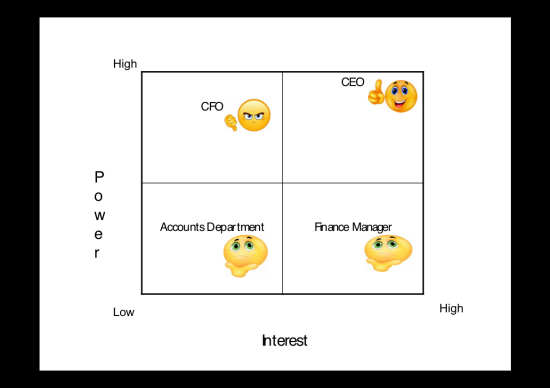“People don’t care how much you know until they know how much you care”
Theodore Roosevelt

Excellent Project Managers need to be technically capable, but being good at setting goals; planning; reacting to unexpected events etc. isn’t the whole story by any manner or means. Hard work on a project counts for little if the customer (or stakeholder) feels neglected, ignored or disrespected. So the ‘secret ingredient’ to project success is customer service excellence, and that’s true irrespective of whether the ‘customer’ is an internal sponsor or an external client.
Tell me about the money
Bain & Company research tells us that a customer is 4 times more likely to defect to a competitor if the problem is service-related, rather than price- or product-related.
Marketing Metrics reports that the probability of selling to an existing customer is 60 – 70%; while the probability of selling to a new prospect is 5-20%.
And a 2% increase in customer retention has the same effect as decreasing costs by 10% (Leading on the Edge of Chaos, Emmet Murphy & Mark Murphy.)
So it’s obvious why companies in general, and Project Managers in particular, need to take this topic seriously.
Furthermore, in many organisations, Project Managers are pivotal in driving a company’s Net Promoter Score (NPS). The NPS, which was created by Fred Reichheld, a Senior Fellow at Bain & Co, consists of just one question.
“On a 0 to 10 scale (10 being the highest) how likely would you be to recommend _______ to a colleague or a friend?”
The single score comes from taking the percentage of 10’s and 9’s (promoters) and subtracting them from the percentage of 6’s and below (detractors). The 7’s and 8’s are considered passives and therefore are not counted. Bain & co suggests that an NPS leader will out grow its competitors by a factor of two.
Thus, the NPS score provides a ‘trigger’ to really focus on the customer and that’s where the skills and techniques of customer focus can start to make a positive contribution to building strong, lasting relationships.
So how can Project Managers deliver great customer focus to go along with good technical ability…
Owning the relationship
Part of the skill of being excellent at Customer Focus is the capacity to be able to anticipate the customer’s needs, and this means taking the time to think through how to deal with their concerns in advance of any meeting. Clearly, if you can accurately identify what ‘wins’ the customer needs (e.g. a quick delivery) then you can shape arguments to take account of those factors. Also, thorough planning is important because any suggestions that are supported by hard evidence are more likely to be accepted by the customer than those that are not backed up with hard data. A number of techniques come into play in this area, but the most fundamental is arguably “Stakeholder Analysis”.
Stakeholder Analysis is about (a) identifying and then (b) influencing the key people involved in any given project, deal or decision. Aubrey L. Mendelow, Kent State University, Ohio 1991, suggested allocating the people involved in making decisions about an ‘issue’ to one of 4 quadrants; based on a graph that plots Power to make decisions against Interest in the topic in question.
So there are four ‘classes’ of people to be identified and influenced…
- High Power, High Interest: people that need to be given frequent updates and consulted in advance of any action being taken. Plans may have to be modified, in light of their feedback, in order to gain/keep their support.
- High Power, Low Interest: this group need just enough communication to be kept ‘in the loop’, so they’re not ‘surprised’ by how the project is going.
- Low Power, High Interest: these people need to be kept adequately informed, and canvassed to ensure that any useful ideas they have are captured and acted upon.
- Low Power, Low Interest: monitor these people and provide high level updates, but do not bore them with excessive communication.
Murray-Webster and Simon 2005, suggested adding a third dimension ‘Attitude’ for each person (or group) by adding a tick, cross, coloured dot or emoticon to highlight their views about the issue, project or deal in question. Usually one of three possible attitudes is allocated to each person, they are – Supportive; Neutral; or Obstructive.

Solving Problems & Building Trust
Stakeholders (both internal staff and external customers) understand that issues will arise on projects and that there will be ‘challenges’ that need to be solved. So when technical errors or setbacks occur ‘customers’ want those problems solved and, if they are solved in a timely manner, then (usually) all is well. But where communication is poor they get angry and start to complain e.g. ‘trust’ is lost when calls aren’t returned promptly, action plans aren’t distributed, or Project Managers seem uncertain about what to do etc. So strong relationships are built when you show that you really do care about what the customer is experiencing, and that you’re willing to take prompt action to address their needs.
Research by Dr Janet Curran of Huthwaite Group identified the key factors that lead to a positive experience for customers who have concerns with how a service is being delivered. The research was based on managing relationships with external customers, but the same findings would surely hold true for internal clients. They include:
- Positive First Impressions – looking interested and engaged; taking ownership of the ‘problem’ by saying “I” not “We” or “You”
- Defusing Emotion – using empathy and a sincere apology to help calm angry customers down
- Aiming for a Win/Win outcome – really listening to what their concerns are; getting a solution that makes sense for both sides (not just the customer); making sure that the ‘process’ for getting a solution is agreed by both parties.
- Prompt Follow Up – aligning the internal resources needed to deliver the agreed ‘solution’; keeping the customer up to date on the progress being made.
Reciprocity & Frugal Wows
Dr. Robert Caldini in his well known book on Influence explains that “Reciprocity” is: the in-built inclination to feel grateful for favours and to have a powerful psychological urge to “pay them back,” no matter how small they are.
The ‘reciprocity’ effect can be used to develop good client relationships in a number of ways. One application of this effect simply involves making a small gesture that will have a positive impact on how the customer perceives you. (What are sometimes called “frugal wows”). The small gestures should, of course, be meaningful to the customer and appropriate to the situation; they are especially powerful if they are unexpected. Also (and unsurprisingly) the research shows that the more ‘personalised’ or ‘tailored’ the ‘gesture’ to the customer’s situation, the stronger the impression it made on them.
So in a high street shop a ‘frugal wow’ might be as simple as making eye contact and smiling to greet the customer, or offering to help them carry their goods to their car if they’ve made a big purchase. In the corporate setting it can be that the Project Manager takes the time to reserve a car parking space for a client when they make a site visit, or maybe arranging some sightseeing if people have travelled from overseas, or perhaps providing a report in the customer’s mother tongue, or organising for an interpreter to be present at a key meeting, or sending them an article based on a conversation you’ve had etc.
One word of warning here; ‘frugal wows’ work when you do what is expected of you, reliably, and are sincere about wanting to do what’s best for customers. It’s the cherry on top of the cake. They won’t help if you’re getting basic things wrong. By way of a small personal example, I once had someone in reception at a hotel ask me brightly if everything was alright with my stay, just after I had complained to her about something – autopilot service mantra!
Facts tell but stories ‘sell’
If a Project Manager wants to persuade a ‘stakeholder’ to agree to something, one of the most effective strategies they can adopt is to tell a ‘story’. Green, Melanie C.; Brock, Timothy C. (Journal of Personality and Social Psychology, Nov 2000) found that a good story ‘pulls’ people into the narrative and makes them less aware that they are being influenced, reduces skepticism and counter arguing. So telling an anecdote about the lead up to a problem and the development of a solution is much more effective (from an influencing perspective) than just giving someone the straight facts.
So effective Project Managers will give the ‘history’ of the idea and not just the solution they propose e.g. “we first became aware there was an issue about six weeks ago when we saw (y) happening…so we started by exploring the options…and as a result of that work we recommend that we implement option (x)”
Good stories (according to research by Mazzocco & Green, Ohio State University) are…
- Well delivered (good pace and clear voice)
- Use imagery (describes the scene in terms of what you’d see, hear, and feel if you were there)
- Realistic (content is believable)
- Logically structured and ‘concise’
- Tailored to the audience’s level of interest and understanding
So what’s next???
Reflect on how you handle your communication with project stakeholders at present. Do you think carefully about what they want and need from you? Do you have a robust methodology for handling meetings and providing updates? What improvements could you make?
Reading
Practical People Engagement: Leading Change Through the Power of Relationships, L Mayfield P (Elbereth Publishing)
Online
Watch this twelve minute YouTube clip giving an overview of 3 aspects of delivering a great story based on analysing the work of US comedian Kevin Hart. Of course the behaviours shown are ‘stronger’ than you’d use in the corporate setting, but the principles are valid and clearly demonstrated.
Courses
Consider sending your Project Managers on our two-day, ‘Customer Focus’ course (which looks in detail at how to build great client relationships and has been run over 50 times, across three continents.)
Coaching
If you are a senior executive maybe a ‘one to one’ Executive Coaching Session would be a useful option for helping you improve your relationship building skills.
And to end, an insightful and often reproduced quote…
